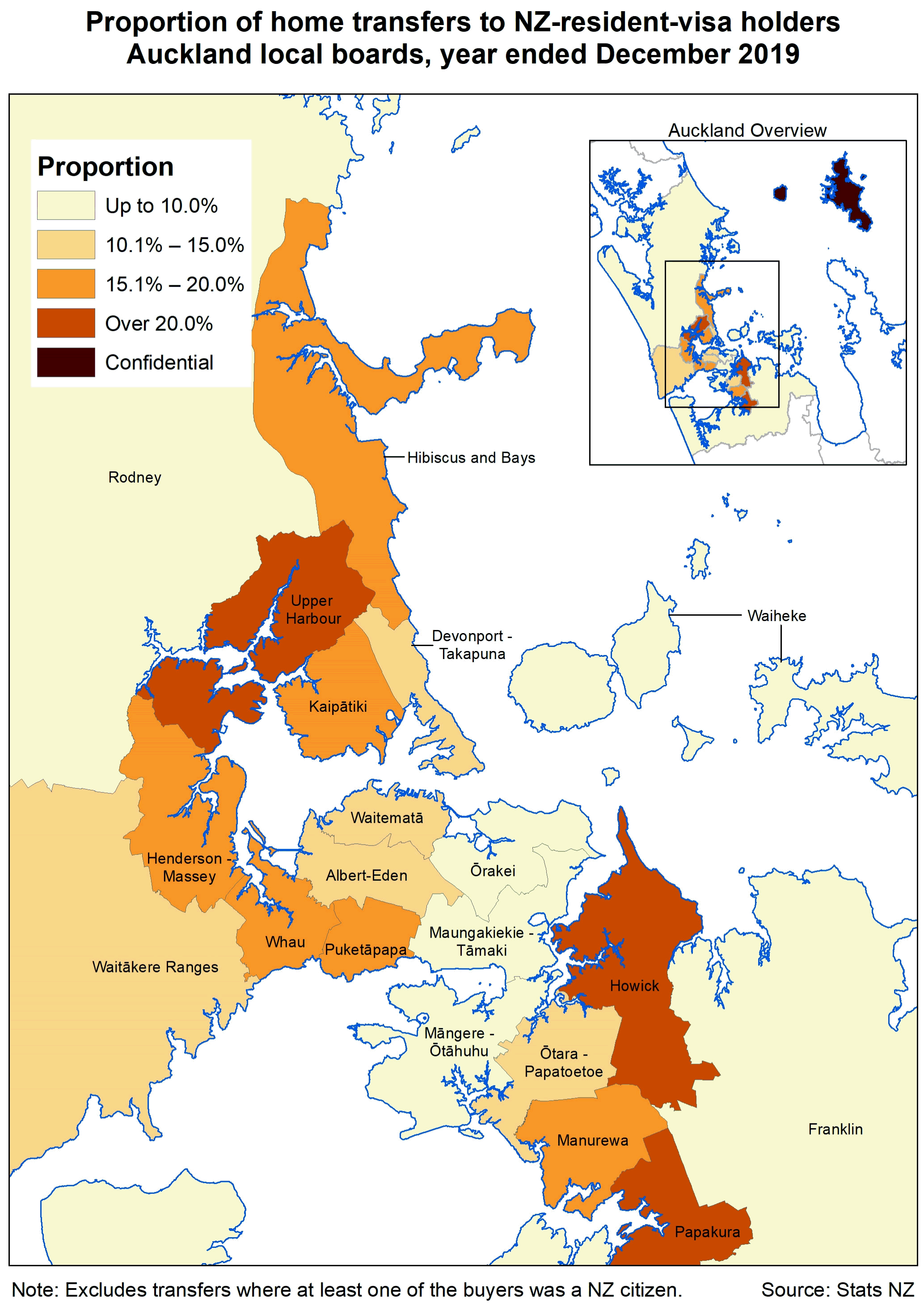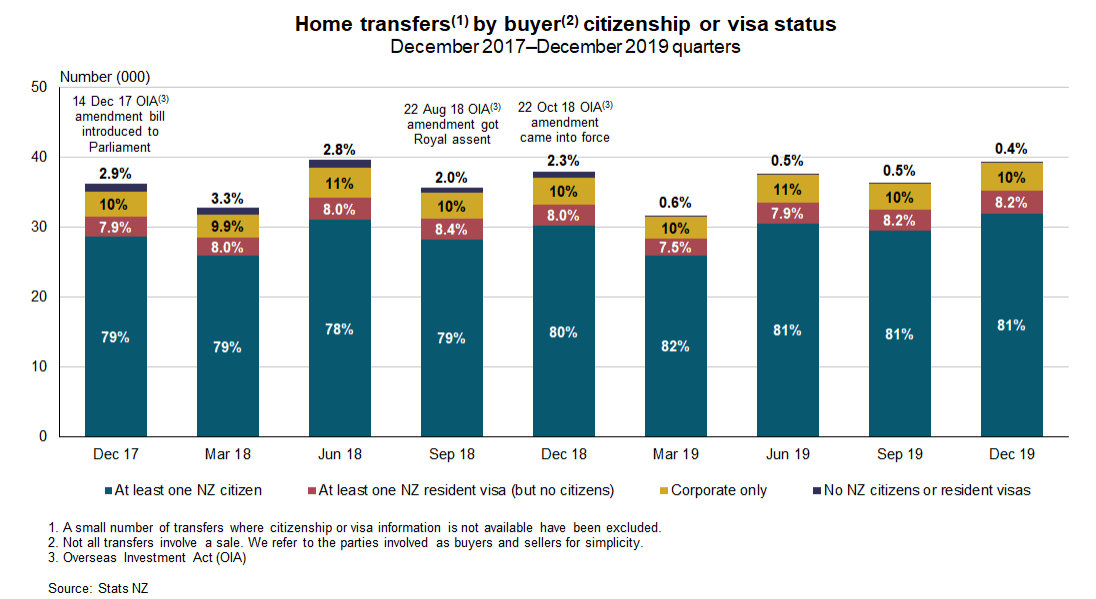1 in 4 Akl Upper Harbour homes go to resident-visa holders
by Statistics New ZealandA quarter of all home transfers in Auckland’s Upper Harbour were to NZ-resident-visa holders in the year ended December 2019, Stats NZ said today.
“Auckland home transfers to resident-visa holders ranged from 6 percent in Rodney to 25 percent in Upper Harbour,” property statistics manager Melissa McKenzie said.
“While resident-visa holders consistently account for about a quarter of Upper Harbour home transfers, transfers to overseas people fell from 10 percent of home transfers in 2018 to only 0.5 percent in 2019.”
Upper Harbour includes areas of significant new housing development such as Hobsonville Point.
About half the people living in Upper Harbour were born overseas. Some of those born overseas are NZ citizens or hold resident visas, while others are living in New Zealand on work or student visas and counted as overseas people in the property transfer statistics.
See New Zealand’s population reflects growing diversity and Statistical area 1 dataset for 2018 Census for more information on the number of people born overseas.

Nationally, transfers to NZ-resident-visa holders accounted for 8 percent of all home transfers in the year ended December 2019, relatively unchanged from 2018.
The resident-visa category includes people who may have only recently gained residency, as well as those who may have lived in New Zealand for many decades. It excludes transfers where at least one of the buyers was a NZ citizen. It also excludes transfers where all of the buyers were corporate entities or overseas people.
Transfers to NZ citizens still dominate nationally (over 80 percent in 2019), while the share of transfers to people without NZ citizenship or a resident visa fell from 2.6 percent in 2018 to 0.5 percent in 2019 due to restrictions on the sale of residential land to overseas people which came into force on 22 October 2018.
Home transfers to overseas people fall to 0.4 percent in December 2019 quarter
Transfers to people without NZ citizenship or a resident visa accounted for 0.4 percent (or 147 home transfers) of all home transfers in the December 2019 quarter. This was down from 0.5 percent (186 home transfers) in the September 2019 quarter, and 2.3 percent (885 home transfers) in the December 2018 quarter.

Text alternative for Home transfers by buyer citizenship or visa status, December 2017 to December 2019 quarters
Frequently asked questions
How many ‘foreigners’ are buying New Zealand homes?
It depends how you define ‘foreigner’. In the December 2019 quarter, of all home transfers:
• 81 percent were to at least one NZ citizen
• 10 percent were to corporate entities only (which could have NZ or overseas owners)
• 8.2 percent were to at least one NZ-resident-visa holder (someone who can live and work in New Zealand for as long as they like)
• 0.4 percent were to no NZ citizens or resident-visa holders.
When we talk about transfers to ‘overseas people’, we mean the 0.4 percent of transfers where none of the buyers were NZ citizens or resident-visa holders (excluding transfers where all the buyers were corporate entities). We focus on this measure because it aligns most closely with the definition of ‘overseas person’ in the Overseas Investment Act 2005.
What about the Overseas Investment Amendment Act 2018?
The new Act affects contracts signed from 22 October 2018. As transfers are not counted until completed, it wasn’t as obvious in December 2018 quarter statistics.
The new Act prevents most people who don’t hold NZ citizenship or a resident visa from buying residential property in New Zealand. For further information see Overseas Investment Amendment Act 2018.
Why is the number of home transfers to overseas people not zero?
The number of home transfers to overseas people may never be zero due to Overseas Investment Act exemptions (for example, some new homes, and Australian and Singaporean buyers).
Some contracts signed before 22 October 2018 may take many months before they are completed and counted in these statistics. Apartments bought off the plans may not be transferred to an overseas buyer until construction is complete years after the contract was signed.
How many of the corporate entities have ‘foreign’ owners?
Information on the ownership of corporate entities (by New Zealanders or overseas people) is not currently available, as it is not collected on land transfer tax statements.
How are trusts captured in these statistics?
We count a trust based on the visa or citizenship status of its trustees. If at least one trustee holds NZ citizenship, then the transfer is counted as a transfer to a NZ citizen.
How much New Zealand property is owned by ‘foreigners’?
We do not currently have a register of property owned by overseas people. These property transfer statistics measure overseas involvement in property transfers in any given quarter, but not the total amount of property owned by overseas people.
Can transfers of bare residential land be identified in these statistics?
No, we can’t currently identify bare residential land in these statistics, but it is included, along with homes, commercial, and other land, in total property transfers.
Is the Overseas Investment Act being enforced?
The Overseas Investment Office enforce the Overseas Investment Act. For information on applications by overseas people to buy New Zealand property see Decision summaries and statistics. For information on enforcement where overseas people have bought property without appropriate consent see Enforcement action taken.
What about ‘foreign’ buyers in Australia?
The Australian Foreign Investment Review Board (FIRB) reports on approvals of purchases by overseas buyers.
For further information see Foreign Investment Review Board (FIRB) 2017–18 Annual Report.
Why do you talk about ‘transfers’ not ‘sales’?
A transfer is not the same as a sale. Transfers often involve a sale, but there are many other possible reasons for a transfer (such as marriage settlements, boundary changes, trustee changes, and changes in the share of ownership).
Every sale is a transfer, but not every transfer is a sale. We refer to the parties involved as buyers and sellers for simplicity.
We know the number of transfers to overseas people because this information is collected on land transfer tax statements, which cover all types of transfer and not just sales.
Aren’t there lots of people missing from these numbers?
We have information about the visa status or citizenship of virtually all people who transfer property in New Zealand. The only uncertainty is around the ownership of corporate entities that transfer property.
In addition to statistics about the visa status or citizenship of people who transfer property, we also publish statistics about their tax residency. The tax residency statistics include a large category for parties that are exempt from stating their tax residency on a land transfer tax statement (for example, because the transfer involves their main home). The visa and citizenship statistics are not affected by this exemption, because these people are still required to state their visa or citizenship status.
Tax residency is not the same as nationality. We advise focusing on the statistics about visa or citizenship status (also known as affiliation).
What is the net change in ‘foreign’ ownership of New Zealand property?
We don’t produce a measure of the net change in property owned by overseas people.
If you subtract seller statistics from buyer statistics to calculate a net change in home ownership, it is important to note that:
• between the time of buying and selling a home, owners can move between affiliations (for example, a work-visa holder could become a resident-visa holder or NZ citizen)
• some types of affiliations may sell many newly built homes (for example, corporate entities).
Therefore, net changes for a given affiliation could be understated or overstated.
Text alternative for Proportion of home transfers to NZ-resident-visa holders, Auckland local boards, year ended December 2019
This map shows the percentage of home transfers to at least one NZ-resident-visa holder (but no NZ citizens) for Auckland local boards. Data for this graph is available on table 3 of the following file.
Text alternative for Home transfers by buyer citizenship or visa status, December 2017 to December 2019 quarters
This stacked column graph shows the number and percentage of home transfers by buyer citizenship or visa status (at least one NZ citizen, at least one NZ-resident-visa holder but no citizens, corporate only, and no NZ citizens or resident-visa holders). Also indicated is on 14 December 2017, the Overseas Investment Act (OIA) amendment bill was introduced to Parliament, on 22 August 2018 OIA amendment got Royal assent, and on 22 October 2018 OIA amendment came into force.
Data for this graph is available on table 1 of the following file.